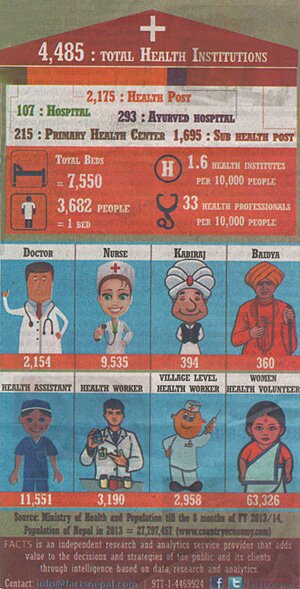Know Nepal
Nepal - An Overview- 2014

Nepal is a small landlocked country situated in between two huge nations: India bordered in the east, south, and west and China in the north (80 degree 12' east longitude and 26 degree 22' and 30 degree 27' north latitude). Area: 140,800 square km between 70 and 8848 meters altitude
Area: 140,800 square km between 70 and 8848 meters altitude
Capital city: Kathmandu, Population: 1,740,977
National Language: Nepali
National Population: 26.6 million
Male Population: 12,927,431 male
Female Population: 13,693,378
Mountain: 7, Hill: 43, Tarai Zone: 50% percent population
Population growth rate: 2.25 per cent per annum
Human Development Index (HDI): 145th among 187 countries
National figure for population under poverty: 25.2
Multidimensional poverty rate: 18.1%
Extreme Poverty: 18.6%
Women received education beyond the school: 17.9
Men received education beyond the school: 39.9
Representation of women in the parliament: 33.2
| Major Health and related Indicators | Status of 2013 |
| Prevalence of Underweight Children aged 6 to 59 months | 28.8 |
| Proportion of stunted children aged 6 to 59 month | 40.5 |
| Net enrolment rate in primary education | 95.3 |
| Infant Mortality Rate (per 1,000 live births) | 46 |
| Under Five Mortality Rate (per 1,000 live births) | 54 |
| Proportion of 1 year old Children immunised against Measles | 88 |
| Maternal Mortality Ratio (per 100,000 live births) | 170 |
| At least 4 ANC visits (%) | 50.1 |
| Proportion of births attended by skilled birth attendant (%) | 50 |
| Contraceptive prevalence rate modern methods (%) | 43.2 |
| Unmet need for family planning (%) | 27 |
| HIV prevalence among Men and Women aged 15-24 years (%) | 0.12 |
| Proportion of population with advanced HIV infection receiving ART (%) | 28.7 |
| Clinical malaria incidence (per 1,000 population) | 3.28 |
| Prevalence rate associated with TB (100,000 population) | 238 |
| Death rate associated with TB (per 100,000 population) | 21 |
| Proportion of people using wood as main fuel | 64.4 |
| Proportion of population using improved drinking water source | 85 |
| Proportion of population using improved sanitation facilities | 62 |
| Source: Adopted from Nepal Millennium Development Goals Progress Report 2013 | |
Sources: Central Bureau of Statistics, 2011, HDI report 2014; topwritingservice.com ,2020,research on the industrial development of the city of Nepal.
